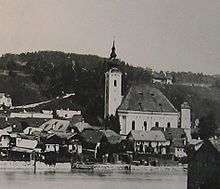Silent-Night-Chapel
The Silent Night Chapel (German: Stille-Nacht-Kapelle) is located in the town of Oberndorf bei Salzburg in the Austrian province of Salzburg, and is a monument to the Christmas carol Silent Night and its librettist, Joseph Mohr and its composer, Franz Xaver Gruber. It stands on the site of the former St. Nicholas's Church, where on December 24, 1818, the Christmas carol was performed for the first time.[1][2]
| Silent Night Chapel | |
|---|---|
 | |
| Location | |
| Location | Oberndorf bei Salzburg, Austria |
| Geographic coordinates | |
| Architecture | |
| Groundbreaking | 1924 |
| Completed | 1937 |
| Website | |
| www | |
History
The church of St. Nicholas was damaged several times in the 1890s by flooding of the Salzach - especially by the flood of 1899, which severely impacted the Altach district and destroyed a large part of the town. This led to the decision that the whole of Oberndorf, including the parish church of St Nicholas, would need to be rebuilt about 800 m upstream.
Due to the high cost of repairs and the continued risk of flooding, the damaged St. Nikola Church was not repaired. Instead, it was replaced in 1906 with a church in the new town center. In 1913 the old parish church was demolished and only a debris cone marked the location where the now-famous Christmas song was first performed.

The 100th anniversary of the song in December 1918 fell at a difficult time immediately after World War I.[3] Still, many of the citizens of Oberndorf wanted to honor the message of peace created by Mohr and Gruber. Begun in 1924, construction of a memorial chapel proceeded slowly under the difficult political and economic conditions of the period (First Republic). The chapel was eventually completed on August 15, 1937, the Feast of the (Assumption). The Memorial Chapel ultimately became the visible symbol of the song Silent Night.
Every year, especially at Christmas, thousands of people from around the world visit the Memorial Chapel and adjacent Museum. At 17:00 (5:00 p.m.) every December 24, a solemn memorial mass is held at the church and guests thrill to the experience of hearing the famous carol sung in their many languages. Since 2002, this celebration has been transmitted by means of the local webcam on the Internet.
Design
The chapel is an octagon in form with a bell helmet and a lantern, and the portal has a hipped roof canopy. The arched windows were created in 1935 by the Tyrolean Stained Glass. The high altar with a relief of the Nativity is by the sculptor Hermann Hutter, from 1915. The predella (altar base) relief of The Adoration of the Magi, The Crucifixion, The Escape from Egypt is by the sculptor Max Domenig, from 1936.[4]
Replicas
Replica models of the Silent Night Chapel exist in the Mini Mundus leisure park at Klagenfurt in Carinthia (1:25 scale) and the model park Mönichkirchen in Lower Austria. Furthermore, there is a 1:1 scale replica in Frankenmuth in the U.S. state of Michigan.
Further reading

- Dehio, Georg; Euler, Bernd; Gobiet, Robert; Huber, Horst (1986). Handbuch der Kunstdenkmäler Österreichs, Salzburg (in German). ISBN 3703105992.
- "Oberndorf bei Salzburg. Silent Night Memorial Chapel". The historical monuments of Austria: Salzburg. Town and country. Dehio manual. Vienna: Verlag Anton Schroll & Co. p. 290.
Bundesdenkmalamt
References
- McDonald, Thomas L. "'Silent Night' Turns 200". National Catholic Register. Retrieved 2018-12-24.
- Van Evra, Jennifer (2018-12-19). "Silent Night turns 200: fascinating facts about the beloved Christmas carol". CBC. Retrieved 2018-12-19.
- Thuswaldner, Gregor (2018-12-12). "As 'Silent Night' turns 200, its Austrian home cracks down on immigrants". Commentary. Chicago Tribune. Retrieved 2018-12-12.
- "Vollmer provides Silent Night chapel" (in German). Spur-G-Blog. 2011-12-19. Retrieved 2013-04-24.
External links
| Wikimedia Commons has media related to Silent Night Chapel. |